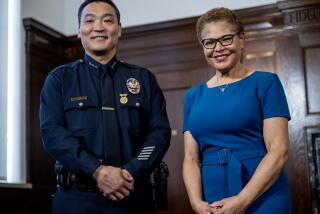Op-Ed: Race disparities in LAPD traffic stops demand a full investigation
A recent Los Angeles Times article analyzing racial disparities in vehicle stops by the Los Angeles Police Department’s Metropolitan division sparked two very different reactions from local stakeholders.
Leaders from affected neighborhoods reacted with alarm to evidence that seemed to confirm their long-held fears of policing that feels more like occupation than protection. LAPD leaders, on the other hand, reacted with frustration at what, in their view, were premature attacks on legitimate crime-fighting tactics.
Those different perceptions must be resolved, and whether that happens through public-police collaboration or through heated confrontation could determine whether the considerable progress toward reform achieved by the department and its civic partners continues or shuts down.
Because L.A. is segregated by race and class, the systemic racial impact is built in when a particular neighborhood is targeted for stepped-up enforcement.
The first step in the process should be a hard, fair look at the impact of the LAPD’s stop policy. Then, if it is found unjustifiable, community leaders should be enlisted to help police devise better tactics.
The surge in vehicle stops dates back to 2015, when political leaders ordered the LAPD to address a spike in South Bureau gang crime. Metro’s vehicle stops soon ballooned 14-fold, with black drivers stopped at a rate five times their share in the overall population. Stops of Latino and Asian drivers also rose sharply. These facts raise preliminary questions that help set the parameters for a deeper examination of the policy.
Some community members immediately assumed the data was proof of racial profiling or intentional discrimination. It’s too soon to draw such a conclusion. The data certainly show increased stops and adverse racial impact. To determine whether or not the stops constitute bias or profiling, we have to know more about why and how the mass stop strategy started, how relevant the strategy was to solving the targeted type of crime, why each stop was made, what happened to stopped drivers, the stop results and the magnitude of the strategy’s impact. This is important analysis that should happen as soon as possible.
That said, when any policy results in a 12-fold average yearly increase in vehicle stops for African Americans, a 19-fold increase for Latinos, and a 45-fold increase for Asian Americans, the response needs to be an immediate, aggressive, evidence-based reassessment of the policy that includes the communities affected. The LAPD and the Police Commission have already begun this process.
Even if the policies are not intentionally discriminatory, the department must examine whether they cause unintentional harm or adverse racial impact.
Because L.A. is segregated by race and class, the systemic racial impact is built in when a particular neighborhood is targeted for stepped-up enforcement. At the same time, in my experience, the vast majority of officers’ actions are not consciously driven by racial profiling. LAPD officers of all races will tell you that they police more aggressively in high-crime areas of the city like South Bureau, where 80% of the Metropolitan division’s car stops occurred. While this is different from sheriffs waiting on I-5 to pull over Latino drivers, to a Los Angeles driver who got stopped multiple times or for no good reason, it can feel the same.
And even if data eventually show that the surge in stops helped reduce violence, that benefit must be weighed against the cost to community trust. If a tactic produces a modest reduction of crime but major harm to trust, it might be smarter to use less corrosive tactics.
Enter the Fray: First takes on the news of the minute »
There is no question that residents of high-crime areas want safety. But 80% of more than 4,000 residents of South Bureau surveyed by the Community Coalition said they wanted that safety to come primarily from responsive police who understand and feel a part of their neighborhoods.
Quasi-paramilitary, preemptive tactics like mass stops will always belong in the LAPD’s repertoire. The question is whether they are being used legally, fairly, rarely and wisely. With help from courts, police commissioners, neighborhood leaders, the L.A. news media, advocates, politicians, and foundations, the department has advanced. This is not your grandfather’s LAPD, but it’s no wonder that an innocent driver stopped three times by three different LAPD units in a single day might not see much difference.
The LAPD’s painful past still rings in community ears, and despite progress, one key goal dating back to the 1965 Watts riots is still a work in progress: transforming the relationship between police and poor minority residents into one of trust. That will require collaborative public-police partnerships focused on fair solutions that serve community needs. A thorough examination of these stops is a necessary first step.
Connie Rice is a Los Angeles civil rights attorney and the author of “Power Concedes Nothing.” constancerice56@gmail.com
More to Read
A cure for the common opinion
Get thought-provoking perspectives with our weekly newsletter.
You may occasionally receive promotional content from the Los Angeles Times.






